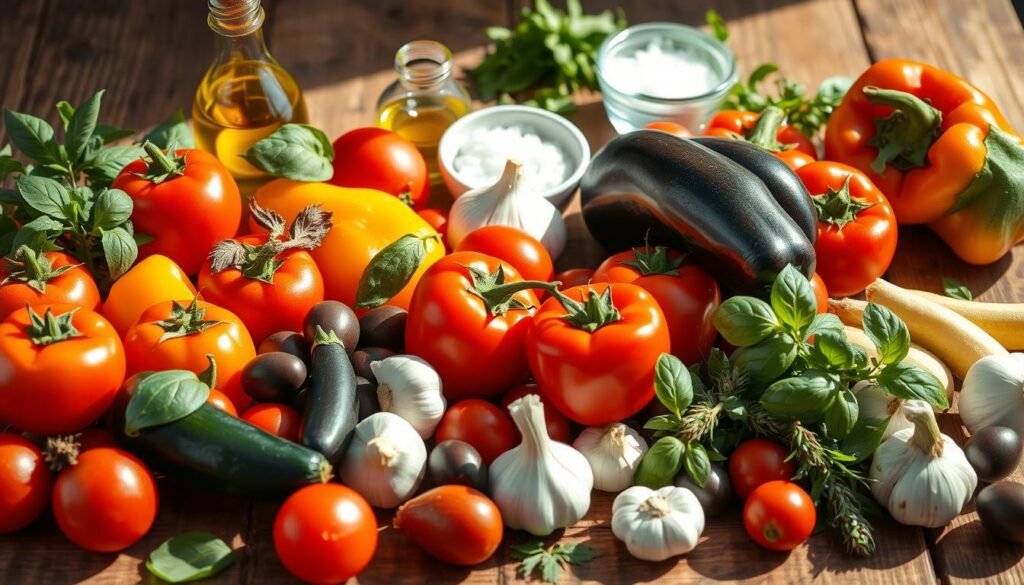Have you ever wondered how to whip up a delicious, veggie-packed ratatouille in a flash? As a busy home cook, I’ve perfected a quick and easy method that allows you to enjoy the bold flavors of this classic French dish with minimal time and effort. In this article, I’ll share my secrets for crafting five mouthwatering Mediterranean-inspired vegetable dishes that are perfect for any night of the week.
What sets my approach apart? I’ve discovered a simple technique that allows you to quickly simmer the vegetables until they’re soft and jammy, without losing their vibrant colors or distinct textures. Whether you’re craving a comforting one-pot meal or a flavorful side to complement your main dish, these rapid ratatouille recipes are sure to become your new go-to options for healthy, satisfying eating.
Key Takeaways
- Discover a speedy method for crafting delicious ratatouille dishes
- Explore 5 quick and easy Mediterranean-inspired veggie recipes
- Learn how to achieve the perfect texture and flavor in your ratatouille
- Enjoy ratatouille as a main course, side dish, or meal prep option
- Customize the recipes to suit your personal taste preferences
What is Ratatouille?
Ratatouille, a classic French dish, is a flavorful and vibrant vegetable stew that has deep roots in the culinary traditions of Provence, a region in the south of France. This peasant dish, with its origins dating back to the 18th century, was initially a practical way for locals to use an abundance of seasonal vegetables grown in their gardens.
Origins and History of the Classic French Dish
Over time, ratatouille has become a celebrated symbol of Provençal cuisine and its popularity has spread throughout France and across the globe. This dish represents the essence of the Mediterranean diet, emphasizing the use of fresh, seasonal ingredients and the joy of communal dining. Ratatouille’s enduring legacy as a beloved French cuisine classic is a testament to the timeless appeal of simple, peasant dish preparations that showcase the natural flavors of the land.
“Ratatouille is a dish that brings people together, celebrates the bounty of the earth, and reminds us of the beauty in simplicity.”
Whether served as a main course or a side, ratatouille’s vibrant medley of Provence ‘s finest vegetables—zucchini, eggplant, bell peppers, and tomatoes—is a testament to the enduring appeal of Mediterranean diet fare.
The Magic of Mediterranean Ingredients
At the heart of the classic ratatouille dish lies the vibrant produce of the Mediterranean region. From the plump tomatoes and tender eggplants to the zucchini and peppers, each ingredient plays a crucial role in creating the dish’s signature flavor profile. These Mediterranean cuisine staples are not only visually stunning but also packed with a wealth of nutrients and antioxidants.
Beyond the produce, the dish’s aromatic quality is elevated by a carefully curated selection of seasonings and herbs. A pinch of salt, a dash of pepper, and a sprinkle of paprika lend depth and complexity to the stew, while the earthy notes of dried rosemary and the fresh, fragrant touches of thyme and basil create a harmonious balance.
To tie it all together, a drizzle of high-quality extra virgin olive oil and a splash of red wine and sherry vinegar add the perfect finishing touches. The peppery notes of a Spanish Hojiblanca olive oil, for instance, provide a delightful contrast to the sweetness of the cooked vegetables, resulting in a truly captivating and well-rounded dish.

“The secret to a great ratatouille is in the quality of the ingredients. When you use the freshest, most vibrant produce from the Mediterranean region, the flavors come alive in a way that is truly magical.”
By harnessing the power of these Mediterranean cuisine staples, the humble ratatouille becomes a culinary masterpiece, showcasing the true essence of the region’s bountiful and flavorful offerings.
Essential Ratatouille Ingredients
When it comes to crafting the perfect ratatouille, the key lies in the freshest, most flavorful seasonal produce. This classic Mediterranean stew truly shines when you use the right combination of eggplant, onions, bell peppers, garlic, tomatoes, and zucchini.
Produce, Seasonings, Herbs, and Oils
Start with a vibrant selection of vegetables. Opt for plump, ripe eggplants, yellow onions, and a mix of colorful bell peppers – perhaps green, red, and yellow. Garlic is a must, as are juicy, vine-ripened tomatoes. Round out the lineup with tender zucchini.
For seasoning, reach for the bold flavors of paprika, dried rosemary, and fresh thyme and basil. A high-quality extra virgin olive oil with a slightly peppery finish, like a Spanish Hojiblanca, will bring it all together.
| Ingredient | Quantity |
|---|---|
| Eggplant | 1 medium |
| Yellow onion | 1 large |
| Bell peppers (assorted colors) | 2-3 |
| Garlic cloves | 3-4 |
| Tomatoes | 4 medium |
| Zucchini | 1 medium |
| Paprika | 1 tsp |
| Dried rosemary | 1 tsp |
| Fresh thyme | 2 tbsp |
| Fresh basil | 1/4 cup |
| Olive oil | 1/4 cup |
With these essential ingredients on hand, you’re well on your way to creating a truly authentic and flavorful ratatouille.
One-Pot Ratatouille Recipe
Preparing a delectable ratatouille doesn’t have to be a time-consuming task. In fact, you can whip up this classic Mediterranean vegetable dish in a single pot, allowing the flavors to meld together seamlessly. Let’s dive into the step-by-step process of crafting a flavorful one-pot ratatouille.
Step-by-Step Instructions
First, start by salting the eggplant cubes to draw out any bitterness. This simple step helps to enhance the overall flavor profile of the dish. Next, sauté the onions and bell peppers in a large pot until they’ve softened and caramelized slightly.
Once the aromatics are ready, add the minced garlic, diced tomatoes, and sliced zucchini and eggplant. Pour in a splash of red wine to deglaze the pot, and then stir in your choice of fresh herbs, such as basil or thyme.
Bring the mixture to a boil, then reduce the heat and let it simmer until the vegetables are tender but still retain their shape. This could take around 20-30 minutes, depending on the size of your vegetable pieces.
To finish, stir in a drizzle of olive oil and a splash of sherry vinegar to brighten the flavors. Allow the ratatouille to rest in the warm pot for about an hour, letting the ingredients meld together before serving.

The key to this one-pot ratatouille recipe is patience and allowing the flavors to develop over time. By simmering the vegetables together, you’ll create a harmonious blend of eggplant, zucchini, tomato, onion, bell pepper, and garlic that’s sure to delight your taste buds.
Tips for Perfect Ratatouille
Crafting a delectable ratatouille requires a few key tricks up your sleeve. First and foremost, how you chop the vegetables can make all the difference in the world. While some prefer a small, uniform dice, I tend to go for a more rustic, chunky texture by cutting the veggies into 1-inch pieces. This allows them to become velvety soft without losing all of their natural texture.
Another vital step is salting the eggplant. This simple technique helps draw out any bitterness and break down the spongy texture, resulting in a richer, more flavorful dish. Be sure to let the salted eggplant sit for at least 30 minutes before rinsing and patting it dry.
Finally, allowing the ratatouille to rest in the warm pot for about an hour before serving is a game-changer. This rest period allows the flavors to settle and deepen, creating a harmonious symphony of Mediterranean goodness.
“Ratatouille is not just a dish; it’s a work of art, where every ingredient plays a crucial role in creating a masterpiece.”
By keeping these tips in mind, you’ll be well on your way to crafting the perfect ratatouille, complete with vibrant colors, tender vegetables, and a depth of flavor that will have your taste buds dancing.
The Best Way to Serve Ratatouille
Ratatouille, the classic French vegetable dish, is a versatile and delectable option for any meal. While the dish itself is packed with flavor, there are several ways to elevate your ratatouille experience. One of the most popular serving suggestions is to enjoy it just warm, topped with a perfectly runny fried egg and a slice of crusty French baguette on the side.
Ratatouille also makes a wonderful side dish that pairs excellently with simple roast meats like lamb or chicken. For a more substantial meal, consider serving the ratatouille alongside another French classic, the Niçoise salad, to create a complete and satisfying dinner.
Though ratatouille needs no further embellishment, it’s truly a versatile dish that can be enjoyed in many ways. Whether you choose to top it with a fried egg, serve it alongside roasted meats, or incorporate it into a larger French-inspired spread, this Mediterranean veggie medley is sure to impress.
| Serving Suggestion | Description |
|---|---|
| Fried Egg and Crusty Bread | Ratatouille served warm, topped with a runny fried egg and a piece of crusty French baguette on the side. |
| Roast Meats | Ratatouille makes a delicious side dish to simple roast meats like lamb or chicken. |
| Niçoise Salad | Serve ratatouille alongside the classic French Niçoise salad for a complete and satisfying meal. |
No matter how you choose to serve it, ratatouille is a true delight for the senses. Its vibrant colors, rich flavors, and versatility make it a cherished dish in the Mediterranean culinary repertoire.
Storing and Reheating Leftovers
As a passionate food enthusiast, I’ve learned that ratatouille is a dish that actually gets better with time, making it a perfect candidate for storing as leftovers. Whether you’ve whipped up a big batch or have some extra servings left over, there are a few simple steps to ensure your ratatouille stays fresh and flavorful.
To store your ratatouille, the key is to allow it to cool completely before transferring it to an airtight container. This helps prevent the veggies from getting soggy or losing their texture. Once cooled, you can keep the ratatouille in the refrigerator for 3-4 days, ready to reheat and enjoy whenever the craving strikes.
For longer-term storage, ratatouille can be frozen in individual portions for up to 6 months. This is a great way to have a taste of the Mediterranean just a freezer away. When you’re ready to indulge, simply reheat the ratatouille on the stovetop, adding a splash of broth or water if it seems a bit dry.
| Storage Method | Shelf Life |
|---|---|
| Refrigerator | 3-4 days |
| Freezer | Up to 6 months |
With these simple storage and reheating tips, you can enjoy the flavors of your homemade ratatouille leftovers for days or even weeks to come. Whether you’re refrigerating, freezing, or just reheating your ratatouille, the key is to keep it fresh and flavorful, so you can savor every bite.
Rapid Ratatouille: 5 Speedy Mediterranean Veggie Dishes
In addition to the classic ratatouille recipe, there are many other quick and delicious Mediterranean veggie dishes to try. These 5 speedy options showcase the vibrant flavors and healthy ingredients of the Mediterranean diet, perfect for busy weeknights. From roasted vegetable salads to one-pan meals, these recipes make it easy to incorporate more plant-based, seasonal produce into your diet.
- Roasted Vegetable and Quinoa Salad: A colorful mix of zucchini, bell peppers, and onions, roasted to perfection and tossed with fluffy quinoa, feta, and a tangy lemon-herb dressing.
- Mediterranean Vegetable Frittata: Eggs baked with sautéed eggplant, tomatoes, spinach, and feta, making for a satisfying and protein-packed meal.
- One-Pan Ratatouille Pasta: Tossing roasted ratatouille vegetables with whole-wheat pasta, garlic, and a sprinkle of Parmesan creates a quick and nutritious dinner.
- Grilled Vegetable Skewers: Colorful bell peppers, zucchini, and onions marinated in a Mediterranean-inspired blend of olive oil, lemon, and herbs, then grilled to smoky perfection.
- Mediterranean Veggie Wraps: Hummus, feta, and a variety of crunchy veggies like cucumbers, tomatoes, and red onions, all wrapped up in a whole-wheat tortilla for a portable and satisfying meal.
These 5 speedy Mediterranean veggie dishes are not only delicious but also incredibly versatile. Serve them as main courses, sides, or even meal-prep them for easy, healthy lunches throughout the week. Embrace the vibrant flavors and nourishing ingredients of the Mediterranean diet with these quick and convenient vegetarian recipes.

Variations and Customizations
One of the many joys of cooking ratatouille is the opportunity to put your own spin on this classic French dish. While the traditional recipe is undoubtedly delicious, there’s no need to stick to the script when it comes to this versatile Mediterranean stew.
Try adding mushrooms to your ratatouille for a different texture and earthy flavor. Or, for an extra boost of protein and fiber, consider incorporating chickpeas or white beans into the mix. If you’re in the mood for a little spice, don’t be afraid to include some chopped chili peppers or a sprinkle of red pepper flakes.
The possibilities for ratatouille variations are endless, and the beauty of this dish lies in its ability to be customized to your personal taste preferences. So, feel free to experiment and let your culinary creativity shine through.
- Add mushrooms for earthy flavor and texture
- Incorporate chickpeas or white beans for extra protein and fiber
- Include chopped chili peppers or red pepper flakes for a spicy kick
“Ratatouille is a canvas waiting to be painted with your own unique flavors and ingredients.”
So, whether you’re looking to try something new or simply want to put your own spin on a classic, don’t be afraid to get creative with your ratatouille creations. The end result will be a dish that’s both delicious and uniquely your own.
Nutritious and Delicious Meal Options
Ratatouille is not merely a delectable dish, but a veritable nutritional powerhouse. As a veggie-packed Mediterranean delight, this recipe brims with an array of vitamins, minerals, and antioxidants that nourish the body. Serving ratatouille as a main course, accompanied by a hearty grain like quinoa or rice, creates a complete and satisfying meal that caters to a balanced diet.
For a lighter option, ratatouille pairs beautifully with a fresh green salad or can be enjoyed as part of a brunch spread, complemented by roasted potatoes and vegan scrambled eggs. The versatility of this dish allows it to be seamlessly incorporated into a variety of meal plans, ensuring a ratatouille nutrition boost with every bite.
When it comes to serving suggestions for ratatouille, the possibilities are endless. Creamy polenta or mashed potatoes provide a comforting and filling base, while a side of crusty bread or pita makes for a satisfying accompaniment. Regardless of how you choose to serve this Mediterranean masterpiece, it remains a balanced meal that nourishes both the body and the soul.
“Ratatouille is not just a dish, it’s a celebration of the vibrant flavors and nutritional benefits of Mediterranean produce.”
So, whether you’re looking to incorporate more plant-based options into your diet or simply seeking a delicious and nutritious meal, ratatouille is the perfect choice. Embrace the ratatouille nutrition and let this dish become a staple in your culinary repertoire.
Conclusion
Ratatouille is a true celebration of the vibrant flavors and healthy ingredients that define Mediterranean cuisine. This easy one-pot dish showcases the best of summer’s bounty, from juicy tomatoes to tender eggplant and zucchini. With just a few simple steps, I can have a delicious, veggie-packed meal ready in no time.
Whether I enjoy it as a main course, side dish, or even breakfast, ratatouille is a versatile and nutritious addition to any menu. So, I’ll embrace the spirit of Provence and give this speedy Mediterranean classic a try today. With its blend of ratatouille, quick meals, and vegetarian recipes, this dish is sure to become a new staple in my kitchen.
From the classic French origins to the modern adaptations, ratatouille has proven to be a timeless and beloved dish. By incorporating these Mediterranean flavors and ingredients, I can create a nourishing and satisfying meal that’s perfect for any occasion. It’s a delicious way to savor the best of the season and embrace the joys of Mediterranean cuisine.



